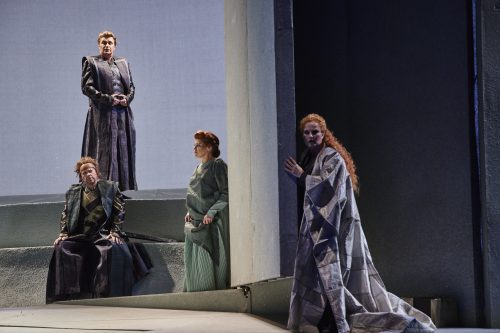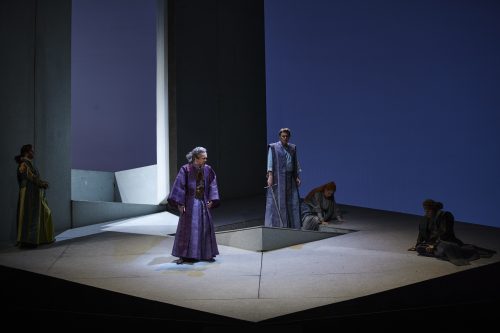Germany Wagner, Tristan und Isolde: Soloists, Sächsischer Staatsopenchor, Sächsische Staatskapelle / Christian Thielemann (conductor). Semperoper Dresden, 21.1.2024. (DMD)

Manufacturing:
Director and Units – Marco Arturo Marelli
Costumes – Dagmar Niefind-Marelli
Lighting – Friedewalt Degen
Refrain director – André Kellingha
Dramaturgy – Hella Bartnig
Forged:
Tristan – Klaus Florian Vogt
Isolde – Camilla Nylund
King Marke – Georg Zeppenfeld
Kurwenal – Martin Gantner
Brangäne – Tanja Ariane Baumgartner
Melot – Sebastian Wartig
Shepherd / Younger Sailor – Attilio Glaser
Helmsman – Lawson Anderson
Wagner noticed his work as Gesamtkunstwerk, a unity of stage design, costumes, lighting, appearing, music and singing; for all these element elements to be of equal significance and to merge into unified expertise for the spectator. In all my expertise as spectator, the efficiency of Tristan und Isolde on the Semperoper Dresden got here closest to attaining this very best, thus taking it to a brand new stage.
This timeless manufacturing was created in 1995. The set consists of a easy dice, not in parallel with the ramp however with one in all its angles pointing like an arrow on the conductor. Whereas this dice is at first on a fair aircraft it’s subsequently raised on the again, making a slope. The partitions on the left and proper facet of the dice present tall doorways of various widths. A gauze encircles the dice for Act II, falling to the bottom when Tristan and Isolde are found by King Marke. The imaginative lighting design creates landscapes of slowly various colors projected towards the partitions, the ground and the gauze. The characters put on flowing robes, which renders them statuesque.
The scale of the stage, the peak of the partitions and the doorways inside them, the color projections and people statuesque characters match the grandeur of the music as carried out by the musicians and singers beneath Christian Thielemann’s conducting. The devices in every part play at an exceptionally excessive stage of unison, which permits the interaction of sections to return to the fore with placing readability and that is mirrored considerably by the interweaving of colors and the undulating costumes. Thielemann can create a sound that genuinely combines orchestral enjoying and singing. They now not sound merely in parallel to one another, roughly arbitrary of their relations, with random moments when one will be heard greater than the opposite or vice versa. Right here the voices develop into a part of the rating, or the rating turns into a part of the singing – they develop into one. Thielemann leads his orchestra in such a refined method, the musicians are so alert, conscious, open, and able to do what he asks them to do at any level all through the complete efficiency {that a} distinctive unity of music and human voice is created. My mode of experiencing time modified dramatically and I used to be fully unaware of time passing: the traditional sequential unfolding of the impressions of sound and visible stimuli merged into one, transcending time.
Such an achievement is feasible solely on the idea of an distinctive stage of rapport between musicians and conductor, mixed with the presence of remarkable singers. For Camilla Nylund, this was the second manufacturing during which she sang Isolde – following her comparatively current debut on this function in Zürich in 2022 (assessment right here). She now inhabits the character totally, each by way of her appearing and her singing, and is in full management and command of her voice, trusts it inherently, enjoys it, relishes it. Thielemann provides the music for her strains exactly the amount, depth and density it wants for music and voice to resonate as one. The rendering of Isolde’s Liebestod, ‘Delicate und leise’, turned, in its hovering strains of melody, each a pure abstract and the inescapable climax of the opera, as by no means earlier than.

Klaus Florian Vogt gave his function debut as Tristan on this efficiency. Many passages of the function have been described by critics and music theorists as troublesome; they’ve certainly gave the impression of laborious work for a lot of notable tenors. When tenors handle to courageous the difficulties with out audible issues, feedback on their efficiency would invariably relate to sturdiness or stamina. These ideas and the associated terminology don’t do justice to Vogt’s Tristan. This debut comes on the proper time for his voice which he has developed through the years with nice and loving care. Because of this, the voice permits Vogt to really – and actually – ‘sing’ the a part of Tristan, all through, with none exception. The voice by no means sounds pressured, pressed, squeezed, slim or strained. He sings gently and lyrically the place acceptable and there’s vocal abandon when needed. With ease – and in full management of his vibrato – Vogt joins the orchestra, leads the orchestra and even overrides the orchestra within the louder passages.
Thielemann gave Georg Zeppenfeld as King Marke the area he wanted to deliver out the perfect in his voice. Very nuanced and with eager consciousness for phrasing, his rendering of Marke’s shades of unhappiness was very transferring certainly. Martin Gantner took inspiration from the leads and trusted the music Wagner had composed for Kurwenal: the phrases are sufficient to point out he’s rougher in nature than Tristan and Gantner sang the music fantastically with a well-focused voice and so didn’t sacrifice any magnificence to match his character. Tanja Ariane Baumgartner supplied a Brangäne who was an impartial girl, sung with a well-rounded, wealthy voice. Sebastian Wartig as Melot, Lawson Henderson because the Helmsman (each firm members of the Semperoper) and Attilio Glaser (firm member at Deutsche Oper Berlin, with a current function debut as Lohengrin) as Shepherd and Younger Sailor have sturdy voices in their very own proper and contributed effectively to a manufacturing that’s distinctive total.
Daniel Meyer-Dinkgräfe
Featured Picture: Klaus Florian Vogt (Tristan) and Camilla Nylund (Isolde) © Semperoper Dresden/Ludwig Olah

